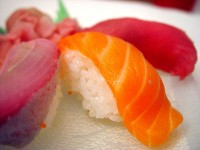
Culinary assimilation inevitably transforms authentic ethnic cuisine into something uniquely American (some might say watered down). And before you know it, you’re eating General Tso’s chicken or Chili’s Southwestern Egg Rolls, which bear little resemblance to anything in either China or south of the border. And as Tim Carman noted in last week’s Washington Post, citing author Trevor Corson, the sushi roll is also an American invention. Carman wonders if we are seeing the end of real sushi—at least for the vast majority of us.
One potential outcome of this shallow talent pool is that poorly trained sushi chefs will beget more poorly trained sushi chefs, the culinary equivalent of that repeatedly photocopied handout from college. Your sushi, in other words, might be a copy of a copy of a copy, until the nigiri you’re about to eat has little connection to the Japanese culture that birthed it.
The nigiri sushi at Sticky Rice certainly leaves much to be desired. Don’t get me wrong: I’m not trying to single out Sticky Rice—mediocre sushi can be found on almost every corner and every strip center in the Washington area … But proper manners aside, the flaws here are obvious: cold, hard rice shaped more like a miniature golf ball than like the classic oblong form found in authentic sushi houses. There is no smear of wasabi rubbed on the undersides of our fish slices, either. When we bite into the tuna and salmon nigiri, the rice doesn’t fall apart on the tongue, as it should, but instead sits there like a stone.
On a visit a few years ago to my hometown of Toms River, N.J., my sister suggested we try the new Chinese buffet down the road. But the Fortune Buffet was not just Chinese-American food, which I would have preferred. It was a mega-buffet that offered everything from Chinese to Thai to American to Japanese fare—all of it mediocre at best. With rows upon rows of food, the setup reminded me of troughs. Why use a tray? How about a feedbag? And the “sushi” counter was a mess. The rice barely held together in blob-like shapes, the fish itself did not look fresh, and the poor chefs looked so depressed working there, rolling their hands around in thankless motions. Nobody cared.
It’s a far cry from what sushi is supposed to be, as Carman writes:
A couple of days earlier, at Okochi’s restaurant [Kaz Sushi Bistro] on I Street NW, the chef reeducated me in the precision and craft of genuine Japanese sushi: the knife skills required for different species of fish; the perfect rice texture; the correct plating of nigiri to accommodate either right- or left-handed chopstick users. (Yes, a good chef at a sushi bar will note your dominant hand.) The cuisine, Okochi says, appeals to the exacting nature of the Japanese.
If Kaz Okochi were to drop by (Mis)Fortune Buffet, the visit might end in seppuku.